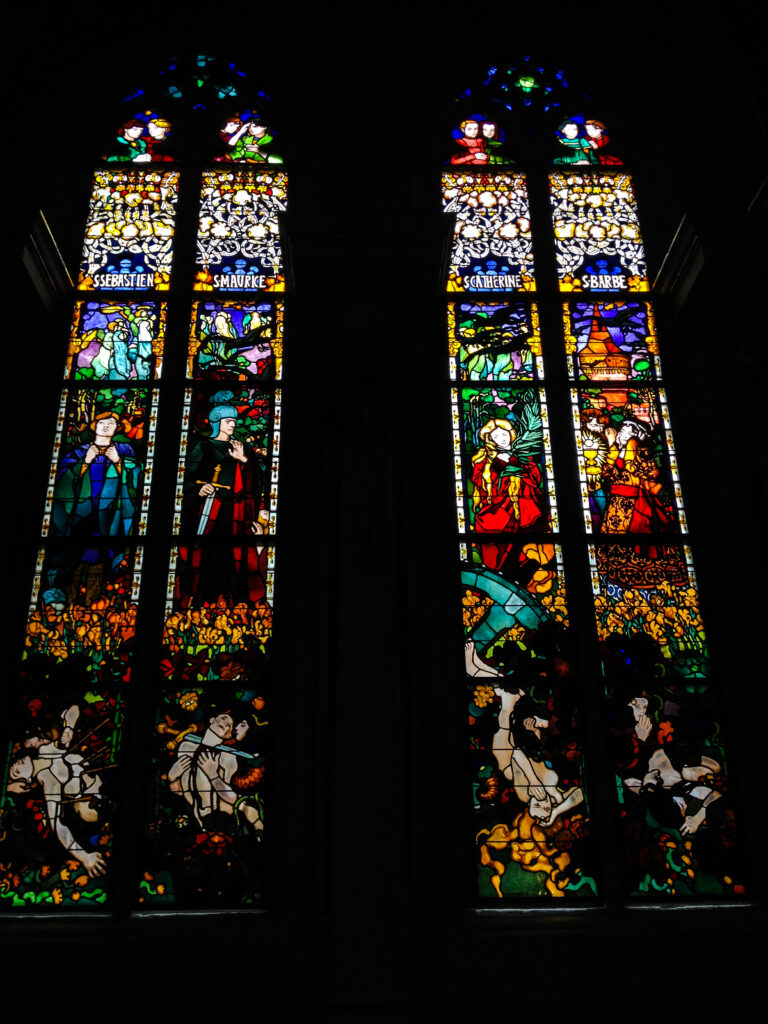by Fr. Anthony Giambrone, OP
Around the turn of the 20th century, a burst of creative energy was transforming the artistic landscape of western civilization in revolutionary ways. In countries such as France and Poland, where both the Catholic and artistic cultures were strong, commanding new expressions of sacred art were being birthed.
One of the most original and overpowering works of this Catholic art nouveau movement is the series of 13 giant stained-glass windows executed by Józef Mehoffer (1869–1946) for the Gothic church of St. Nicholas in Fribourg, Switzerland. Anyone who has ever entered that almost mystical space has experienced the entrancing force of Mehoffer’s masterpiece, which shatters and shapes the dark interior of the church with passionate, swirling belts of faith-laden story, written in harmonious light, awakening the ancient shadows with luminous color.

In 1895, the young Mehoffer won an international competition to decorate the church, and for the next 41 years, he labored at this magnum opus. An entire lifetime of stylistic development is thus present in his monumental glass narratives, which mingle religious and historical scenes. Mehoffer first studied in Krakow with the great Polish master Jan Matejko, whose romantic historical realism serves as the enduring substrate of his disciple’s work. Layers of later influence then came to suffuse Mehoffer’s mature efforts with the deep imprint of art nouveau and art deco.
The famous “window of the martyrs,” which won the gold medal at the Exposition universelle à Paris in 1900, captures the gripping, sinuous feeling of Mehoffer’s genius. Four saints are depicted in four great vertical strips, like four columns of the celestial city.

by Józef Mehoffer. Photo courtesy of Public Domain.
In the lowest register we see their horrible deaths, visualized with graphic pathos, like a Bernini in Tiffany glass: four corpses, wounded bodies, naked flesh splayed out in ecstatic, almost erotic death poses: Sebastian punctured with arrows, oozing out a great blotch of blood-red color; Maurice extinguished while gasping, grasping for his mercilessly slit throat; Catherine crushed by a mangling wheel of torture, fiery hair spilled out in an inverted free fall; Barbara crumpled like a child, dead or sleeping, the object of pity and devotion.
Four feminine faces contemplate these slaughtered martyrs, angelic regards or perhaps the personified Church weeping, lamenting, and praying. Above these scenes grows a garden. “Martyrs are the seed of the Church,” Tertullian said.
Jesus said: “Amen, amen, I say to you, unless a grain of wheat falls to the ground and dies, it remains just a grain of wheat; but if it dies, it produces much fruit” (John 12:24).
Here these martyrs’ deaths spring up as beds of flowers, upon which the glorified saints stand anew, triumphant with the palm of victory in hand.
In his narrative of the Adoration of the Magi, Mehoffer’s rhythmic, narrative prowess comes to bold expression. He discerns here both heaven and hell.
The star leading the kings becomes a massive, alien sun, a worshipful comet, dominating the sky, a kaleidoscopic diamond from Van Gogh’s Starry Night. Below, a wretched, wicked Herod holds court with skeletons and serpents. The apish king grins over his shoulder with wild stupidity, reaping his massacre harvest, counseled by Death and watched over by the brooding, horned devil, his lord.
Yet in the higher realm above, the Lord of Lords, the king of these other kings, is born. Green life brims around him, as angel choirs bind heaven and earth in adoration. As in his image of the martyrs, death reigns below, but life, color, and glory reign with Christ on high.

